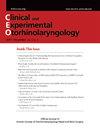Hyaluronan Synthase 1: A Novel Candidate Gene Associated With Late-Onset Non-syndromic Hereditary Hearing Loss
IF 2.9
3区 医学
Q1 OTORHINOLARYNGOLOGY
引用次数: 1
Abstract
Objectives Hyaluronan synthase 1 (HAS1) is a membrane-bound protein that is abundant in the epidermis and dermis, and it is important for skin function. However, its association with hearing loss has not yet been studied. Herein, we sought to evaluate the potential contribution of HAS1: c.1082G>A to genetic hearing loss. Methods We used whole-exome sequencing to analyze blood DNA samples of six patients of a family with autosomal dominant familial late-onset progressive hearing loss, which was revealed to be related to a variant of the HAS1 gene. Confirmatory Sanger sequencing was performed with samples from 10 members. A missense variant was detected in HAS1 (c.1082 G>A, p.Cys361Tyr). In silico analyses predicted this variant to result in the functional loss of HAS1. Immunostaining was conducted using wild-type mouse samples to verify HAS1 expression. Results Has1 was detected in an otocyst at E10.5. In the pup, Has1 expression was localized in the stria vascularis (SV), hair cells, supporting cells of the organ of Corti, and some spiral ganglion neurons. SV marginal cells markedly expressed Has1 in the adult stage. The hearing threshold in the Has1-depleted condition was investigated by accessing the International Mouse Phenotyping Consortium’s Auditory Brainstem Response (ABR) data. ABR of Has1 knock-out mice showed threshold elevations at 6, 12, and 18 kHz in young male adults. Conclusion HAS1 may have a close relationship with auditory function and genetic hearing loss. Further investigation is needed to reveal the precise role of HAS1 in the auditory system. HAS1 is a candidate gene for future hereditary hearing loss genetic testing.透明质酸合酶1:一个与晚发型非综合征遗传性听力损失相关的新候选基因
透明质酸合成酶1 (Hyaluronan synthase 1, HAS1)是一种富含表皮和真皮层的膜结合蛋白,对皮肤功能具有重要作用。然而,其与听力损失的关系尚未得到研究。在此,我们试图评估HAS1: c.1082G>A对遗传性听力损失的潜在贡献。方法采用全外显子组测序对6例常染色体显性家族性晚发型进行性听力损失患者的血液DNA样本进行分析,发现其与HAS1基因变异有关。对10名成员的样本进行验证性Sanger测序。在HAS1中检测到一个错义变体(c.1082)p.Cys361Tyr G >)。计算机分析预测这种变异会导致HAS1的功能丧失。使用野生型小鼠样本进行免疫染色以验证HAS1的表达。结果在E10.5时耳囊肿中检测到Has1。在幼犬中,Has1的表达定位于血管纹(SV)、毛细胞、Corti器官的支持细胞和部分螺旋神经节神经元。成年期SV边缘细胞明显表达Has1。通过访问国际小鼠表型联盟的听觉脑干反应(ABR)数据,研究了has1缺失条件下的听力阈值。Has1基因敲除小鼠的ABR在年轻雄性成年小鼠中显示6、12和18 kHz的阈值升高。结论HAS1可能与听力功能及遗传性听力损失密切相关。需要进一步的研究来揭示HAS1在听觉系统中的确切作用。HAS1是未来遗传性听力损失基因检测的候选基因。
本文章由计算机程序翻译,如有差异,请以英文原文为准。
求助全文
约1分钟内获得全文
求助全文
来源期刊
CiteScore
4.90
自引率
6.70%
发文量
49
审稿时长
6-12 weeks
期刊介绍:
Clinical and Experimental Otorhinolaryngology (Clin Exp Otorhinolaryngol, CEO) is an international peer-reviewed journal on recent developments in diagnosis and treatment of otorhinolaryngology-head and neck surgery and dedicated to the advancement of patient care in ear, nose, throat, head, and neck disorders. This journal publishes original articles relating to both clinical and basic researches, reviews, and clinical trials, encompassing the whole topics of otorhinolaryngology-head and neck surgery.
CEO was first issued in 2008 and this journal is published in English four times (the last day of February, May, August, and November) per year by the Korean Society of Otorhinolaryngology-Head and Neck Surgery. The Journal aims at publishing evidence-based, scientifically written articles from different disciplines of otorhinolaryngology field.
The readership contains clinical/basic research into current practice in otorhinolaryngology, audiology, speech pathology, head and neck oncology, plastic and reconstructive surgery. The readers are otolaryngologists, head and neck surgeons and oncologists, audiologists, and speech pathologists.

 求助内容:
求助内容: 应助结果提醒方式:
应助结果提醒方式:


